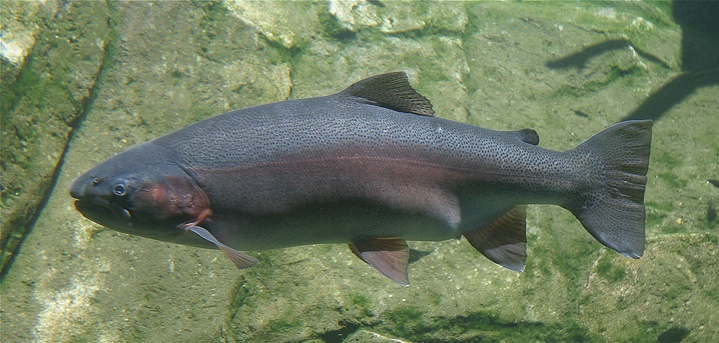Jessica Cejnar / Wednesday, Feb. 26, 2020 @ 4:44 p.m. / Science, Tribes
Tolowa Dee-ni' Nation Seeks Federal Dollars To Resume Salmonid Monitoring on the Smith River

The Tolowa Dee-ni' Nation hope to receive a grant to purchase sonar units to determine the number of adult salmonids, including steelhead, entering the Smith River. Photo: commons.wikimedia.org
The Tolowa Dee-ni’ Nation is pursuing federal dollars to find out how healthy the Smith River’s salmonid population is.
The tribe, owners of the Rowdy Creek Fish Hatchery, plan to purchase two dual-frequency identification sonar (DIDSON) units using a grant from the National Oceanic and Atmospheric
Administration’s Pacific Coastal Salmon Recovery Fund, said Erika Partee, the tribe’s natural resources director.
Partee said the tribe hopes to use the sonar units to determine how many adult salmonids are entering the Smith River. The tribe wants to focus specifically on the chinook and steelhead that are the backbone of that system’s sport fishery, she said.
“For the adult counts, we position the (sonar) as far down in the system as we can,” Partee said, adding that the lower Smith Rivers’ major tributary is Rowdy Creek.
The tribe’s efforts to purchase the DIDSON units received support from the Del Norte County Board of Supervisors, which voted unanimously Tuesday to send a letter of support to NOAA.
According to the board’s letter, the tribe’s proposed project would also include one year of data collection by staff in its fisheries program.
“The Del Norte County Board of Supervisors recognizes that this project will provide valuable adult salmonid escapement data that is currently not being collected on the Smith River, but is essential to managing the fishery,” the Board of Supervisors’ letter states.
The Del Norte Resource Conservation District has been wanting to resume fish counts on the Smith River for about three years, District 3 Supervisor Chris Howard said. Since the California Department of Fish and Wildlife doesn’t want to loan the DIDSON units out, the tribe is pursuing NOAA funds to purchase them permanently, he said.
“After talking with a lot of folks this week during the fish derby, we all believe this is for the best in helping manage our fisheries population in the Smith River,” Howard said.
According to Partee, multiple stakeholders have been pressuring the California Department of Fish and Wildlife to resume fish monitoring on the Smith River. The state is monitoring endangered coho salmon on the Smith River, she said. But the tribe doesn’t feel like enough monitoring is going toward the sport fishery, she said.
“We’ve been working with the California Department of Fish and Wildlife to try to borrow units to conduct the counts,” she said.
Zack Larson, a consultant that specializes in natural resources assessment and monitoring, was contracted with the county to conduct fish counts on the Smith River. He said the last fish count incorporates data from the 2014-15 season.
Larson said he was glad the Board of Supervisors supported the Tolowa Dee-ni’ Nation’s grant application to the Pacific Coastal Salmon Recovery Fund because most state funding is focusing on restoration instead of monitoring.
The state’s monitoring efforts are targeted toward the south because that’s where most threatened salmonid populations are, according to Larson. The Smith River, and its chinook and steelhead populations, on the other hand, are healthy, he said.
Being able to use DIDSON units in the lower part of the Smith River basin will also enable the tribe’s fisheries program to monitor marine mammal abundance in the estuary, Larson said.
“Sonar is used in Alaska to manage the fisheries in real time,” he said. “They learned an immense amount.”
One of the things the tribe hopes to determine is how climate change may have affected the Smith River’s chinook and steelhead populations, Partee said. Using the sonar units to determine the number of adults entering the river will also help the tribe monitor impacts on the Rowdy Creek Fish Hatchery.
“We don’t want to have to wait until our healthy sport fish become endangered before we start monitoring them,” she said.
One drawback to sonar is it can’t differentiate between species, Larson said.
The Tolowa Dee-ni’ Nation’s goal is to determine how many fish overall are entering the river system. When it comes to determining the hatchery contribution
One of the drawbacks to sonar is it can’t differentiate between species, Larson said. The Tolowa Dee-ni’ Nation’s goal is to determine how many fish are entering the river system. When it comes to determining the hatchery contribution, the tribe’s fishery program will use other methods for calculating that data, he said.
In its letter to NOAA, the Board of Supervisors said annual survey is necessary to guide watershed restoration efforts.
“We will work with the tribe to secure sampling sites for unit placement where it is in the county’s power to do so,” the letter states. “We are confident in the Tolowa Dee-ni’ Nation’s ability to secure funding to continue annual counts past the initial year.”
CLICK TO MANAGE